Innovative Dynamic Queue-Length Estimation Using Google Maps Color-Code Data
Abstract
1. Introduction
2. Materials and Methods
2.1. Collection of Color-Code Data from Google Maps
2.2. Survey of the Actual Queue-Length Data
2.3. Data Processing
2.4. Modeling
3. Results and Discussion
3.1. Performance of the Queue-Length Estimation Models
3.2. Variable Importance (VI) Analysis
4. Conclusions
Author Contributions
Funding
Institutional Review Board Statement
Informed Consent Statement
Data Availability Statement
Conflicts of Interest
References
- Venkat, G.; Arulananth, T.S.; Baskar, M. Density Based Traffic Controller with Emergency Override using CCTV Camera. Int. J. Recent Technol. Eng. 2019, 8, 866–869. [Google Scholar] [CrossRef]
- Chuo, H.; Seah, Y.; Tan, K.; Lim, K.; Liau, C.; Kin Teo, K. On-Demand Priority Traffic Optimizer with Fuzzy Logic Microcontroller. In Proceedings of the 2022 IEEE International Conference on Artificial Intelligence in Engineering and Technology (IICAIET), Kota Kinabalu, Malaysia, 13–15 September 2022; pp. 1–6. [Google Scholar]
- Agarwal, H.; Rai, J. Traffic Control System Based on Density with Emergency Priority Mechanism. In Proceedings of the 2022 International Conference on Electronics and Renewable Systems (ICEARS), Tuticorin, India, 16–18 March 2022; pp. 192–197. [Google Scholar]
- Vishnu, U.; Sarma, S.; Yashumithaa, M.; Kr, S.; Gv, V. CNN Based Intelligent Traffic Control System to Support Emergency Vehicles. In Proceedings of the 2022 IEEE International Conference on Electronics, Computing and Communication Technologies (CONECCT), Bangalore, India, 8–10 July 2022; pp. 1–5. [Google Scholar]
- Lee, S.; Wong, S.C.; Li, Y.C. Real-Time Estimation of Lane-Based Queue Lengths at Isolated Signalized Junctions. Transp. Res. Part. C Emerg. Technol. 2015, 56, 1–17. [Google Scholar] [CrossRef]
- An, C.; Wu, Y.; Xia, J.; Huang, W. Real-Time Queue Length Estimation Using Event-Based Advance Detector Data. J. Intell. Transp. Syst. 2018, 22, 277–290. [Google Scholar] [CrossRef]
- Bae, B.; Liu, Y.; Han, L.D.; Bozdogan, H. Spatio-temporal Traffic Queue Detection for Uninterrupted Flows. Transp. Res. B Methodol. 2019, 129, 20–34. [Google Scholar] [CrossRef]
- Yao, J.; Tang, K. Cycle-Based Queue Length Estimation Considering Spillover Conditions Based on Low-Resolution Point Detector Data. Transp. Res. Part. C Emerg. Technol. 2019, 109, 1–18. [Google Scholar] [CrossRef]
- Noaeen, M.; Mohajerpoor, R.; Far, B.H.; Ramezani, M. Real-Time Decentralized Traffic Signal Control for Congested Urban Networks Considering Queue Spillbacks. Transp. Res. Part. C Emerg. Technol. 2021, 133, 103407. [Google Scholar] [CrossRef]
- Jodnok, P.; Pueboobpaphan, R. Estimating Time-Varying Queue Length at Signalized Intersection by Using Color-Coded Traffic on Google Maps. UBU Eng. J. 2021, 14, 48–60. [Google Scholar]
- Keawthong, P.; Muangsin, V.; Gowanit, C. Location Selection of Charging Stations for Electric Taxis: A Bangkok Case. Sustainability 2022, 14, 11033. [Google Scholar] [CrossRef]
- Asgharizadeh, E.; Jooybar, S.; Mahdiraji, H.A.; Garza-Reyes, J.A. A Novel Travel Time Estimation Model for Modeling a Green Time-Dependent Vehicle Routing Problem in Food Supply Chain. Sustainability 2022, 14, 8633. [Google Scholar] [CrossRef]
- Anjaneyulu, M.; Kubendiran, M. Short-Term Traffic Congestion Prediction Using Hybrid Deep Learning Technique. Sustainability 2023, 15, 74. [Google Scholar] [CrossRef]
- Naiudomthum, S.; Winijkul, E.; Sirisubtawee, S. Near Real-Time Spatial and Temporal Distribution of Traffic Emissions in Bangkok Using Google Maps Application Program Interface. Atmosphere 2022, 13, 1803. [Google Scholar] [CrossRef]
- Moon, J.; Hong, J.; Park, T. A Novel Method for Traffic Estimation and Air Quality Assessment in California. Sustainability 2022, 14, 9169. [Google Scholar] [CrossRef]
- Dumitrache, L.; Nae, M.; Simion, G.; Taloș, A.M. Modelling Potential Geographical Access of the Population to Public Hospitals and Quality Health Care in Romania. Int. J. Environ. Res. Public Health 2020, 17, 8487. [Google Scholar] [CrossRef] [PubMed]
- Wu, M.; Ke, C.; Lai, S. Optimizing the Routing of Urban Logistics by Context-Based Social Network and Multi-Criteria Decision Analysis. Symmetry 2022, 14, 1811. [Google Scholar] [CrossRef]
- Rahman, M.A.; Hossain, A.A.; Debnath, B.; Zefat, Z.M.; Morshed, M.S.; Adnan, Z.H. Intelligent Vehicle Scheduling and Routing for a Chain of Retail Stores: A Case Study of Dhaka, Bangladesh. Logistics 2021, 5, 63. [Google Scholar] [CrossRef]
- Tan, T.H.; Gochoo, M.; Chen, Y.F.; Hu, J.J.; Chiang, J.Y.; Chang, C.S.; Lee, M.H.; Hsu, Y.N.; Hsu, J.C. Ubiquitous Emergency Medical Service System Based on Wireless Biosensors, Traffic Information, and Wireless Communication Technologies: Development and Evaluation. Sensors 2017, 17, 202. [Google Scholar] [CrossRef]
- Mishra, S.; Bhattacharya, D.; Gupta, A. Congestion Adaptive Traffic Light Control and Notification Architecture Using Google Maps APIs. Data 2018, 3, 67. [Google Scholar] [CrossRef]
- Rezzouqi, H.; Gryech, I.; Sbihi, N.; Ghogho, M.; Benbrahim, H. Analyzing the Accuracy of Historical Average for Urban Traffic Forecasting Using Google Maps. In Intelligent Systems and Applications; Springer: Cham, Switzerland, 2019; pp. 1145–1156. [Google Scholar] [CrossRef]
- Nair, D.J.; Gilles, F.; Chand, S.; Saxena, N.; Dixit, V. Characterizing Multicity Urban Traffic Conditions Using Crowdsourced Data. PLoS ONE 2019, 14, e0212845. [Google Scholar] [CrossRef]
- Maps, G. Use Layers to Find Places, Traffic, Terrain, Biking & Transit. Available online: https://support.google.com/maps/answer/3092439?hl=en&co=GENIE.Platform%3DDesktop#zippy=%2Ctraffic (accessed on 10 November 2022).
- Alex. Google Maps Traffic Color Legend—The 4 Colors Explained. Available online: https://stereoupgrade.com/google-maps-traffic-color-legend/ (accessed on 10 November 2022).
- Jodnok, P. Estimation of Queue Lengths at a Signalized Intersection Using Google Maps’ Color-Code Traffic Information; Suranaree University of Technology: Nakhonratchasima, Thailand, 2020. [Google Scholar]
- Xu, N.; Xu, Y.; Yan, Y.; Guo, Z.; Wang, B.; Zhou, X. Evaluating Road Lighting Quality Using High-Resolution JL1-3B Nighttime Light Remote Sensing Data: A Case Study in Nanjing, China. Remote Sens. 2022, 14, 4497. [Google Scholar] [CrossRef]
- Navarro-Espinoza, A.; López-Bonilla, O.R.; García-Guerrero, E.E.; Tlelo-Cuautle, E.; López-Mancilla, D.; Hernández-Mejía, C.; Inzunza-González, E. Traffic Flow Prediction for Smart Traffic Lights Using Machine Learning Algorithms. Technologies 2022, 10, 5. [Google Scholar] [CrossRef]
- Sihag, G.; Parida, M.; Kumar, P. Travel Time Prediction for Traveler Information System in Heterogeneous Disordered Traffic Conditions Using GPS Trajectories. Sustainability 2022, 14, 10070. [Google Scholar] [CrossRef]
- Li, X.; Bai, R. Freight Vehicle Travel Time Prediction Using Gradient Boosting Regression Tree. In Proceedings of the 2016 15th IEEE International Conference on Machine Learning and Applications (ICMLA), Anaheim, CA, USA, 18–20 December 2016; pp. 1010–1015. [Google Scholar]
- Ma, X.; Ding, C.; Luan, S.; Wang, Y. Prioritizing Influential Factors for Freeway Incident Clearance Time Prediction Using the Gradient Boosting Decision Trees Method. IEEE Trans. Intell. Transp. Syst. 2017, 18, 2303–2310. [Google Scholar] [CrossRef]
- Yang, S.; Wu, J.; Du, Y.; He, Y.; Chen, X. Ensemble Learning for Short-Term Traffic Prediction Based on Gradient Boosting Machine. J. Sens. 2017, 2017, 7074143. [Google Scholar] [CrossRef]
- Cheng, J.; Li, G.; Chen, X. Research on Travel Time Prediction Model of Freeway Based on Gradient Boosting Decision Tree. IEEE Access 2019, 7, 7466–7480. [Google Scholar] [CrossRef]
- Biau, G.; Scornet, E. A Random Forest Guided Tour. TEST 2016, 25, 197–227. [Google Scholar] [CrossRef]
- Natekin, A.; Knoll, A. Gradient Boosting Machines, A Tutorial. Front. Neurorobot. 2013, 7, 21. [Google Scholar] [CrossRef]
- R Core Team. R: A Language and Environment for Statistical Computing; R Foundation for Statistical Computing: Vienna, Austria, 2022. [Google Scholar]
- Kuhn, M. Caret: Classification and Regression Training. 2022. Available online: https://cran.r-project.org/web/packages/caret/caret.pdf (accessed on 10 January 2023).
- Greenwell, B.; Boehmke, B.; Cunningham, J.; Developers, G.B.M. gbm: Generalized Boosted Regression Models. 2022. Available online: https://cran.r-project.org/web/packages/gbm/gbm.pdf (accessed on 10 January 2023).
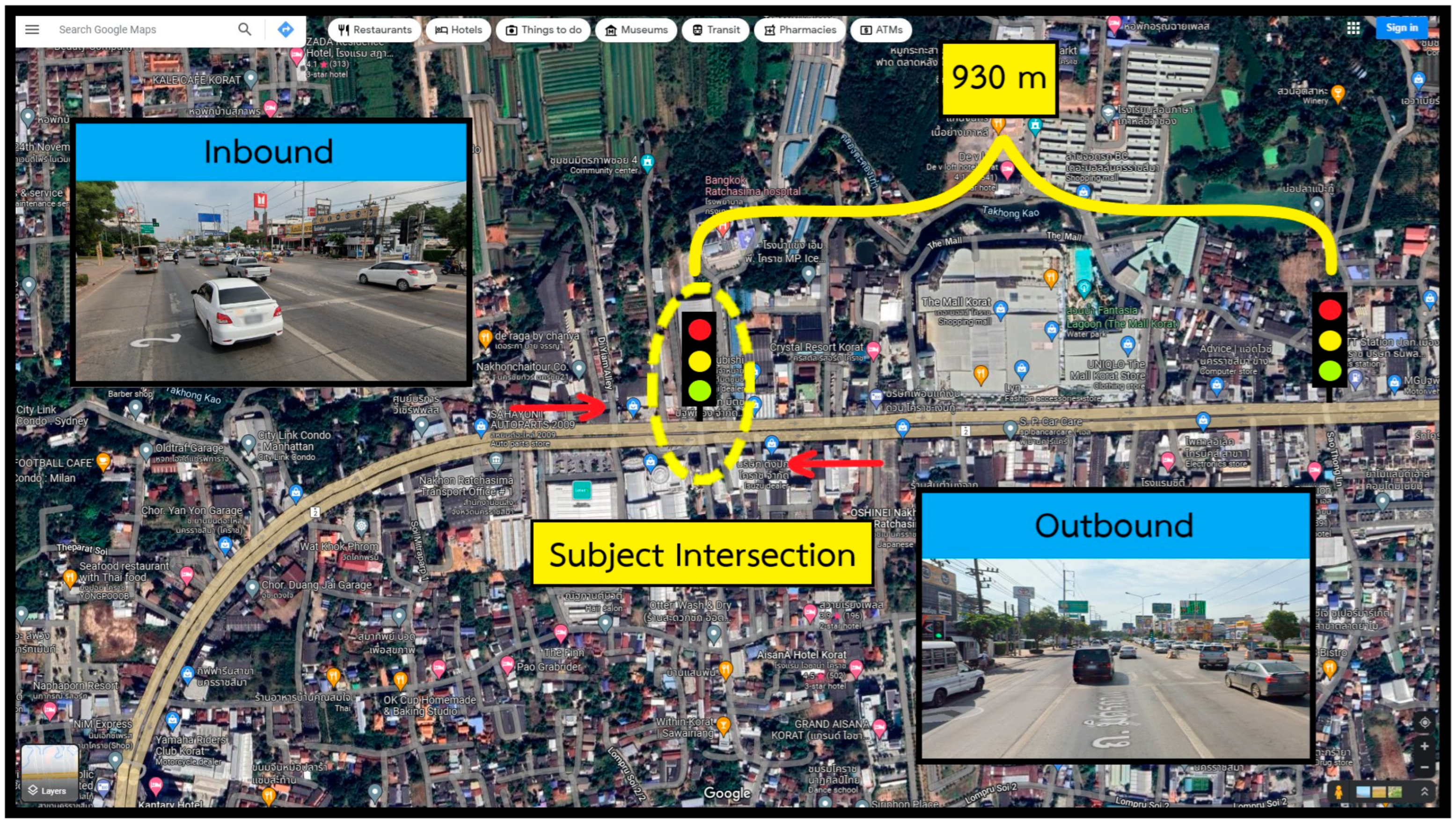
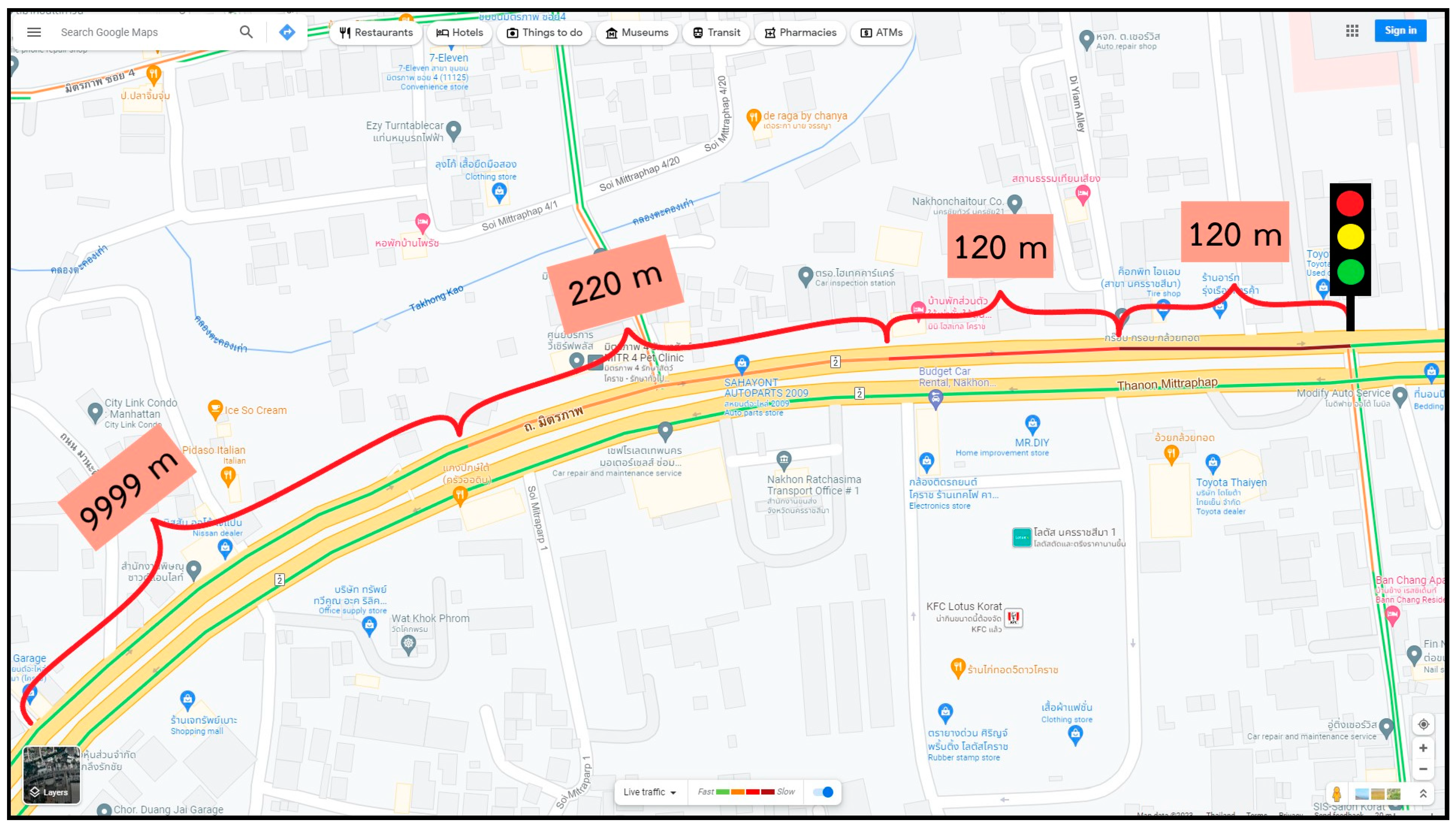
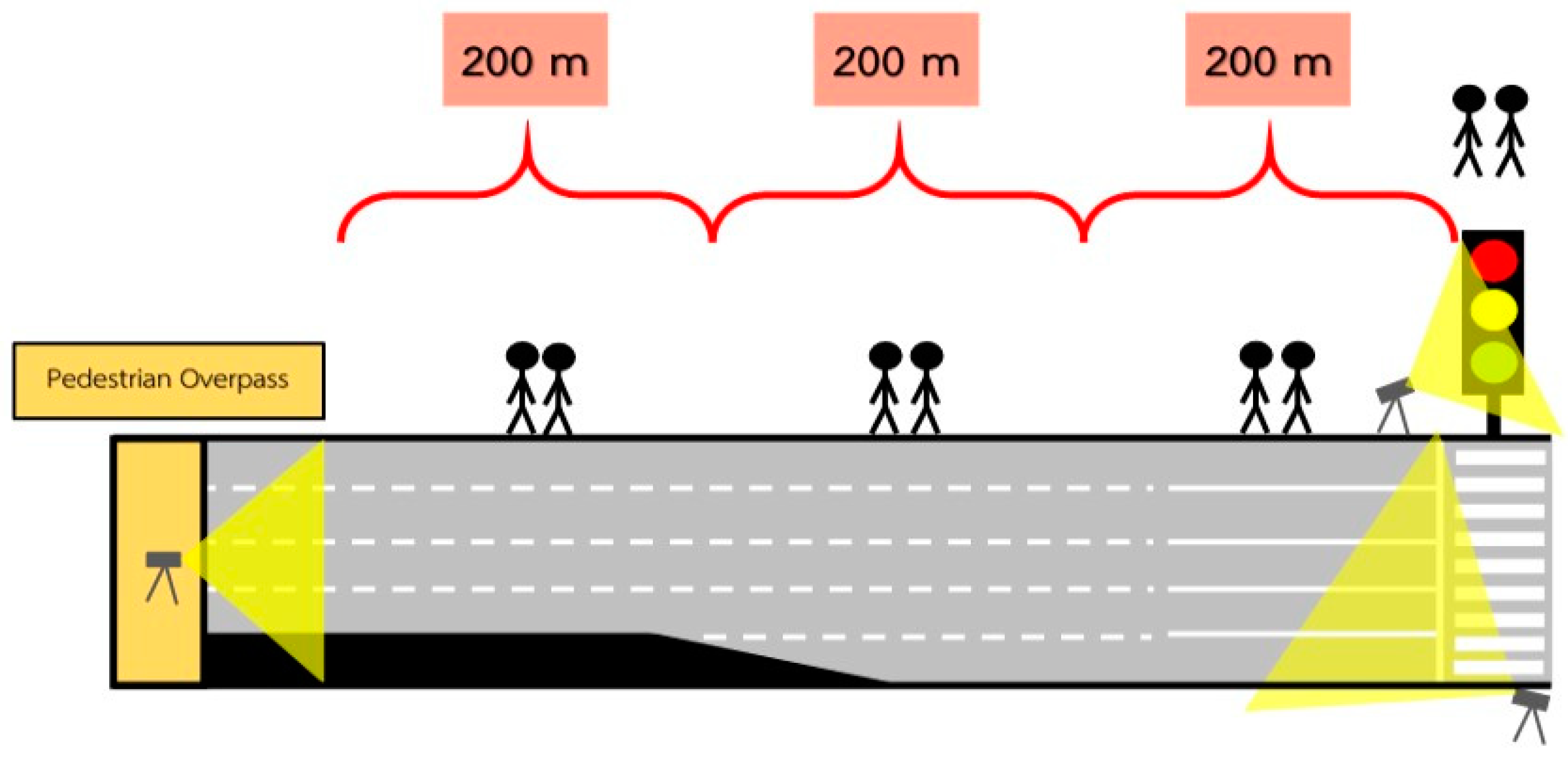
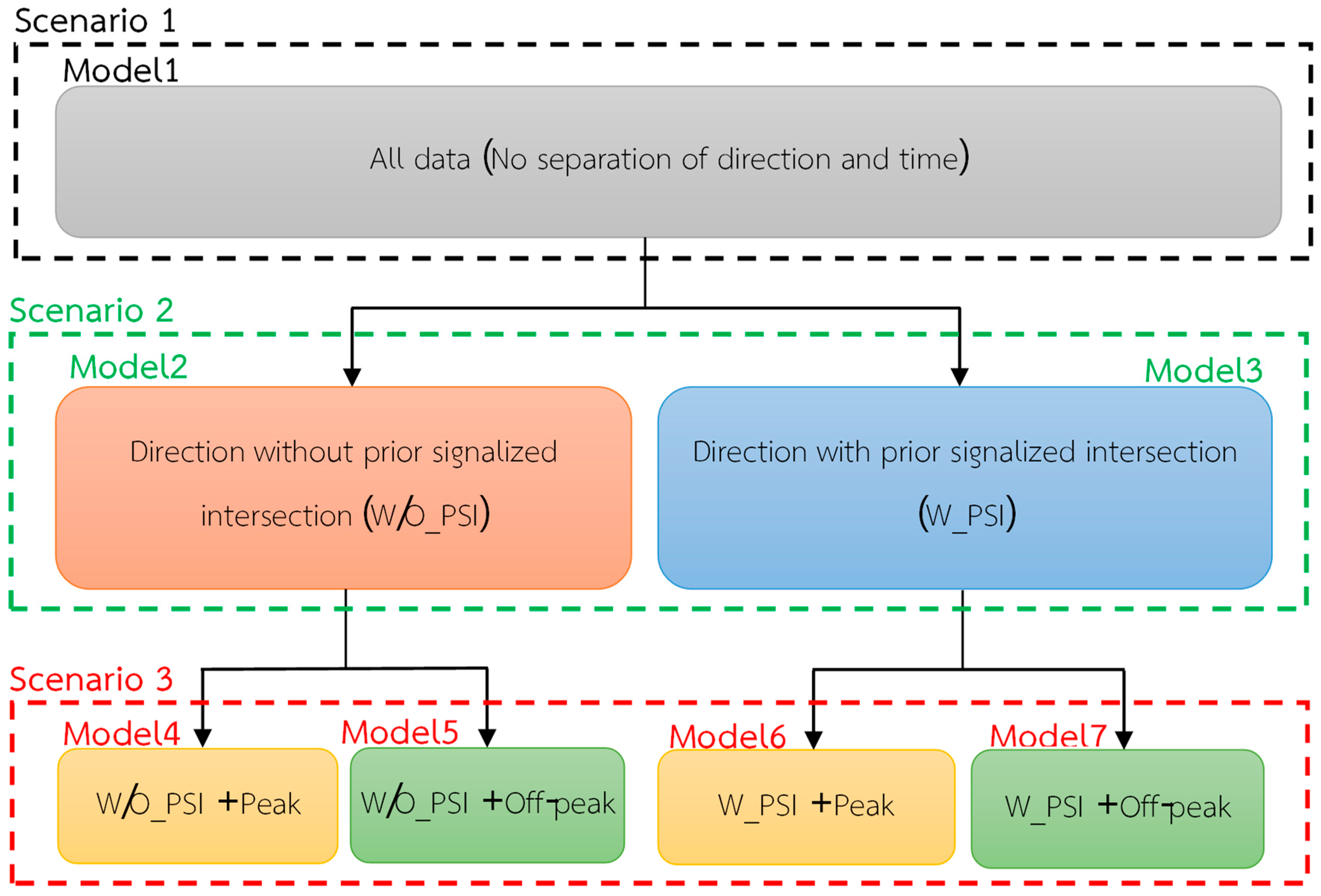
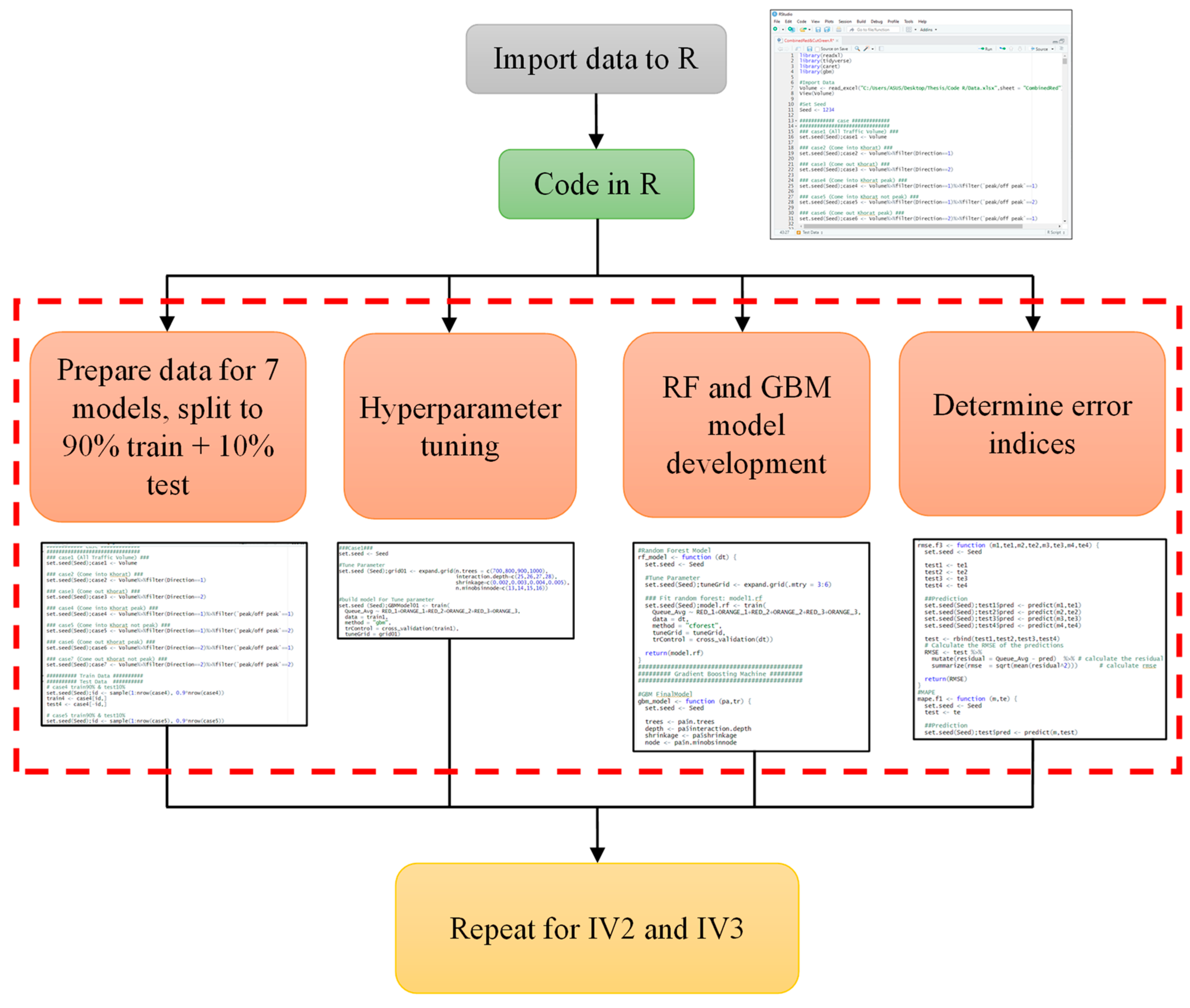
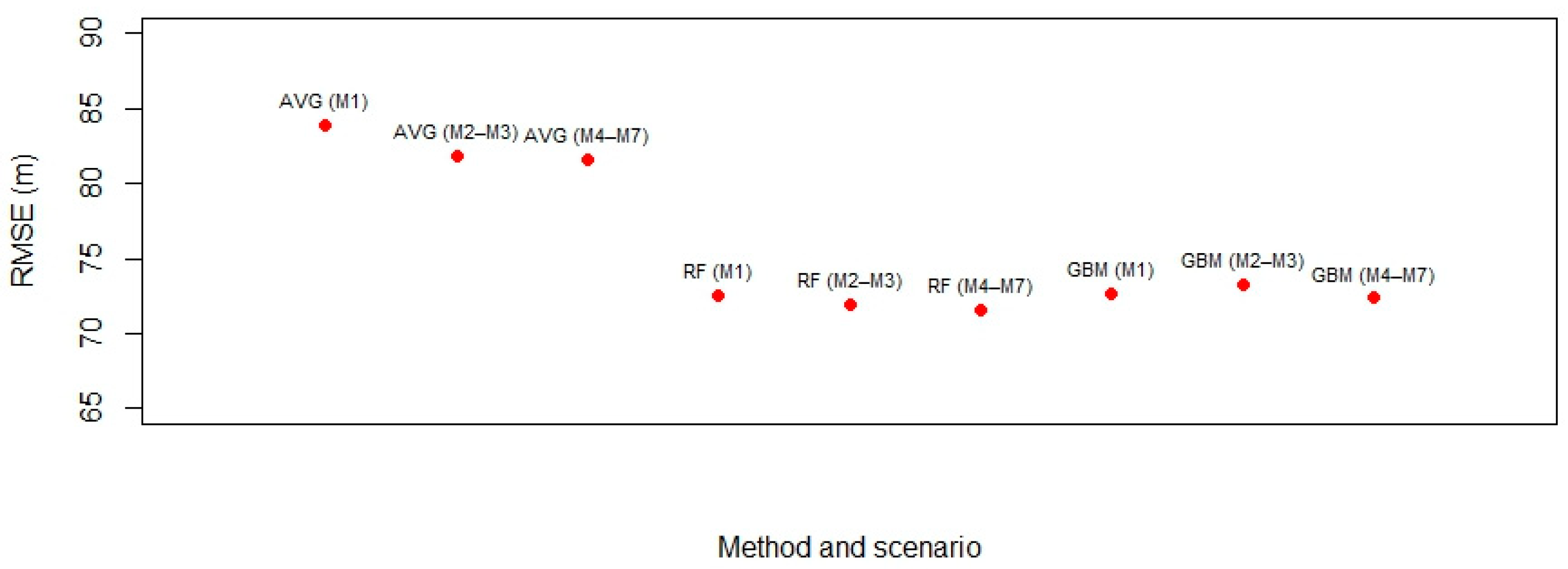
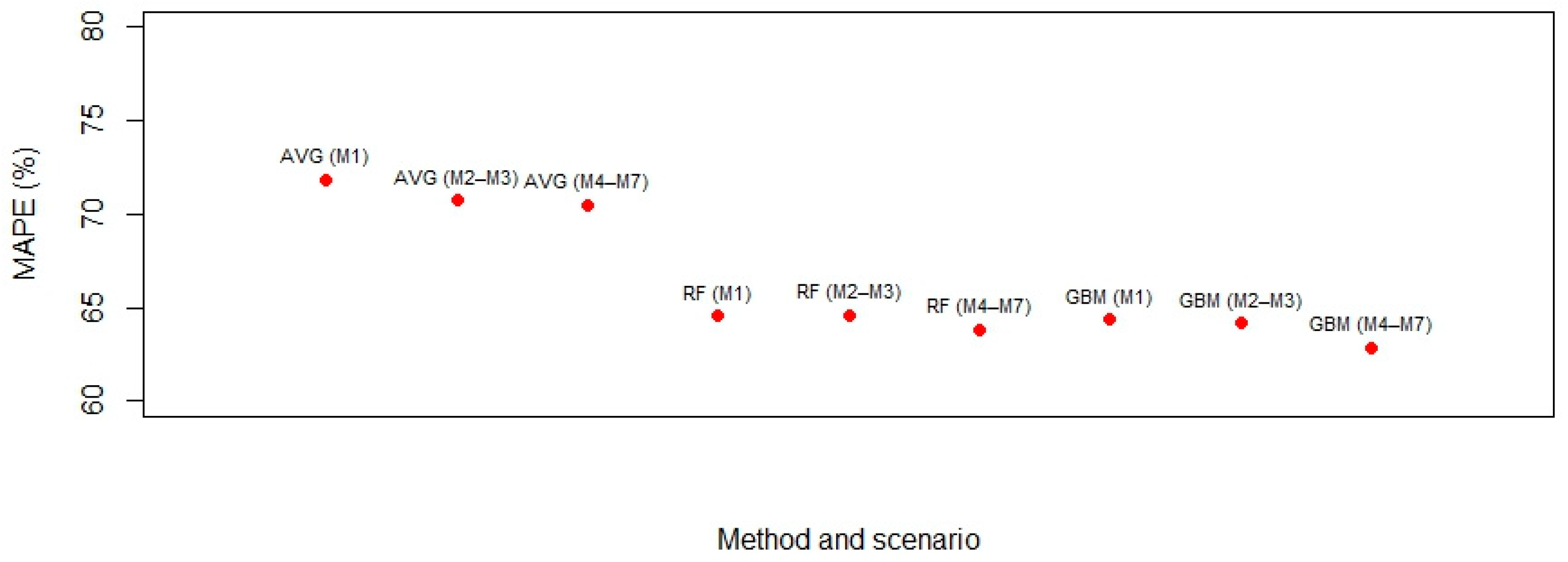
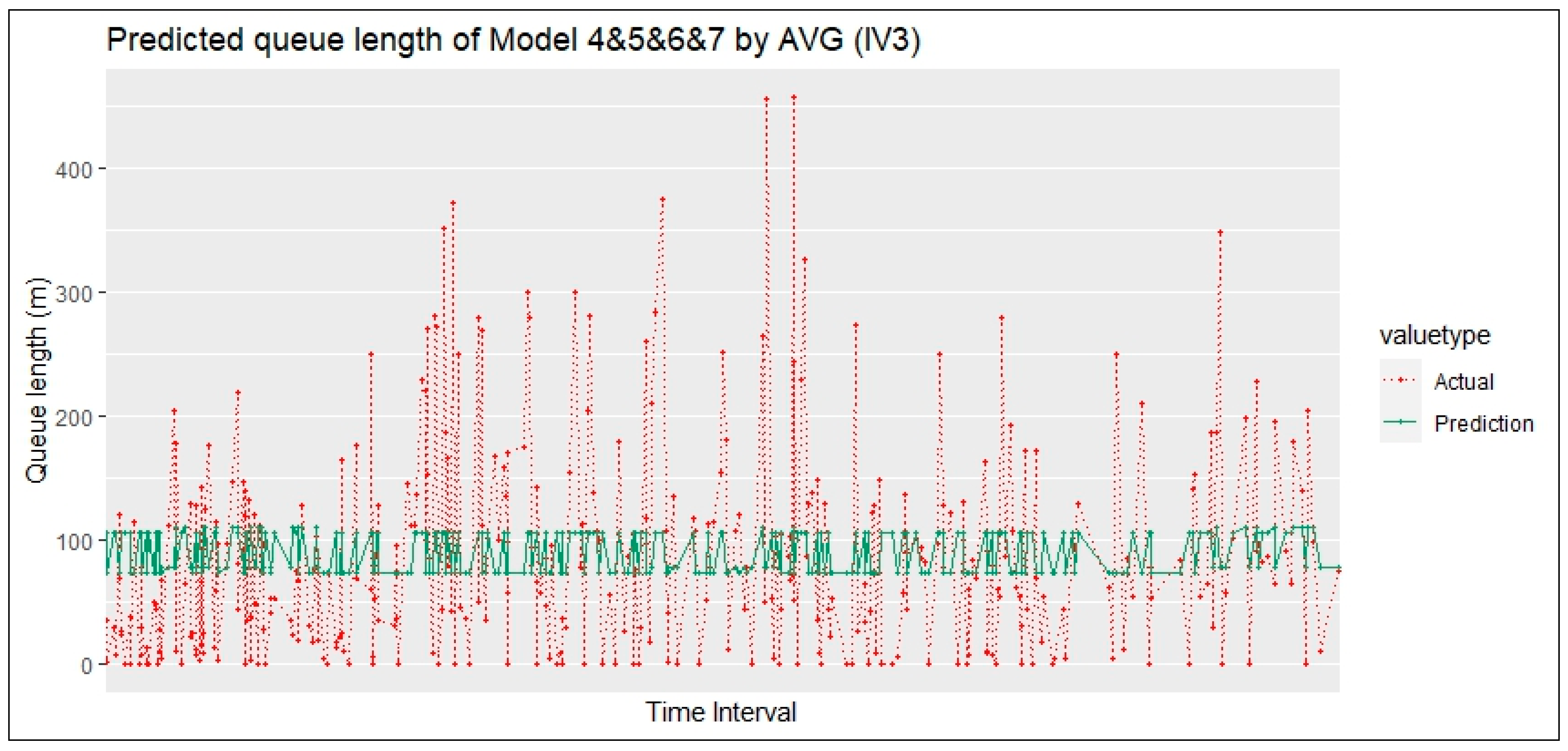
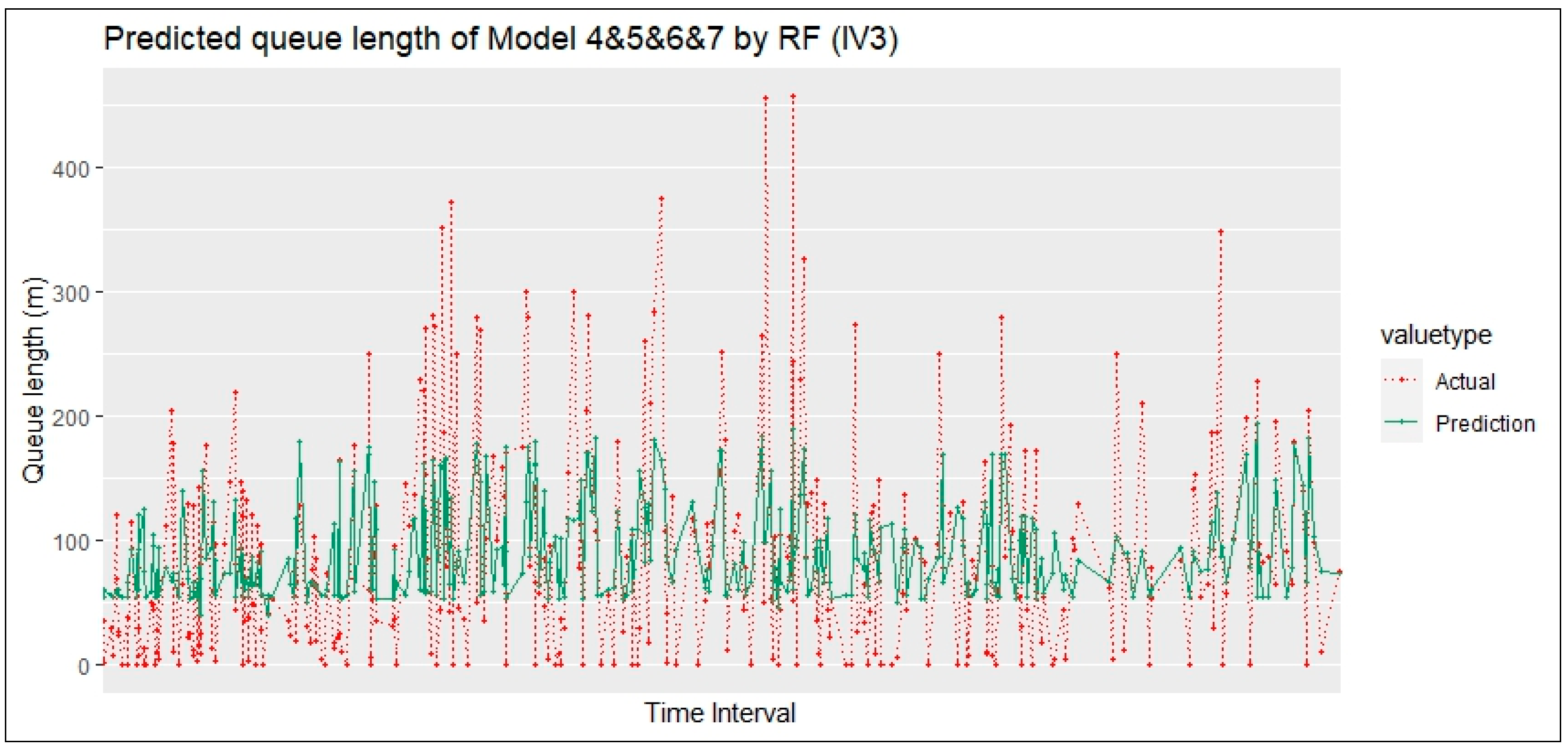
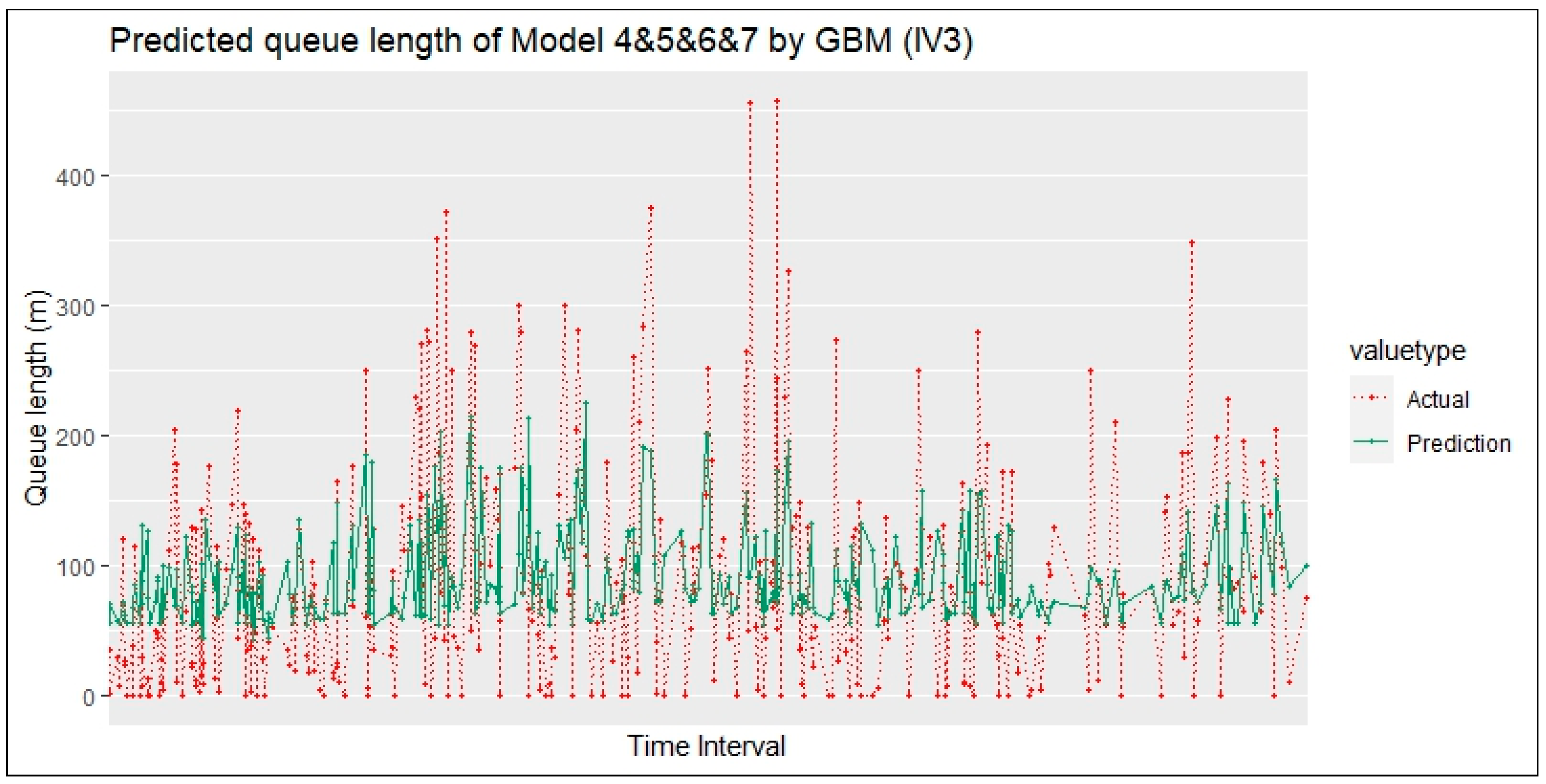
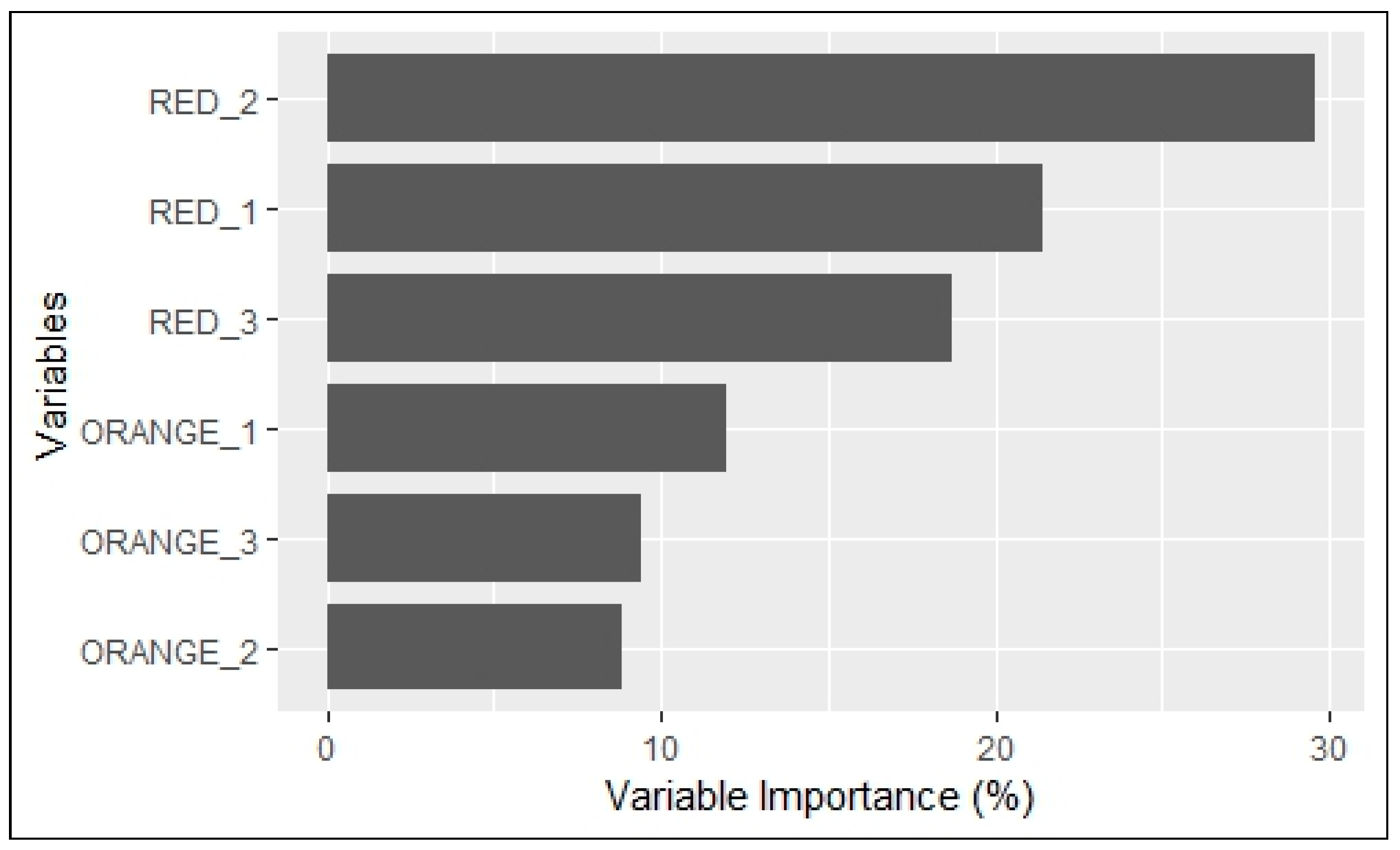
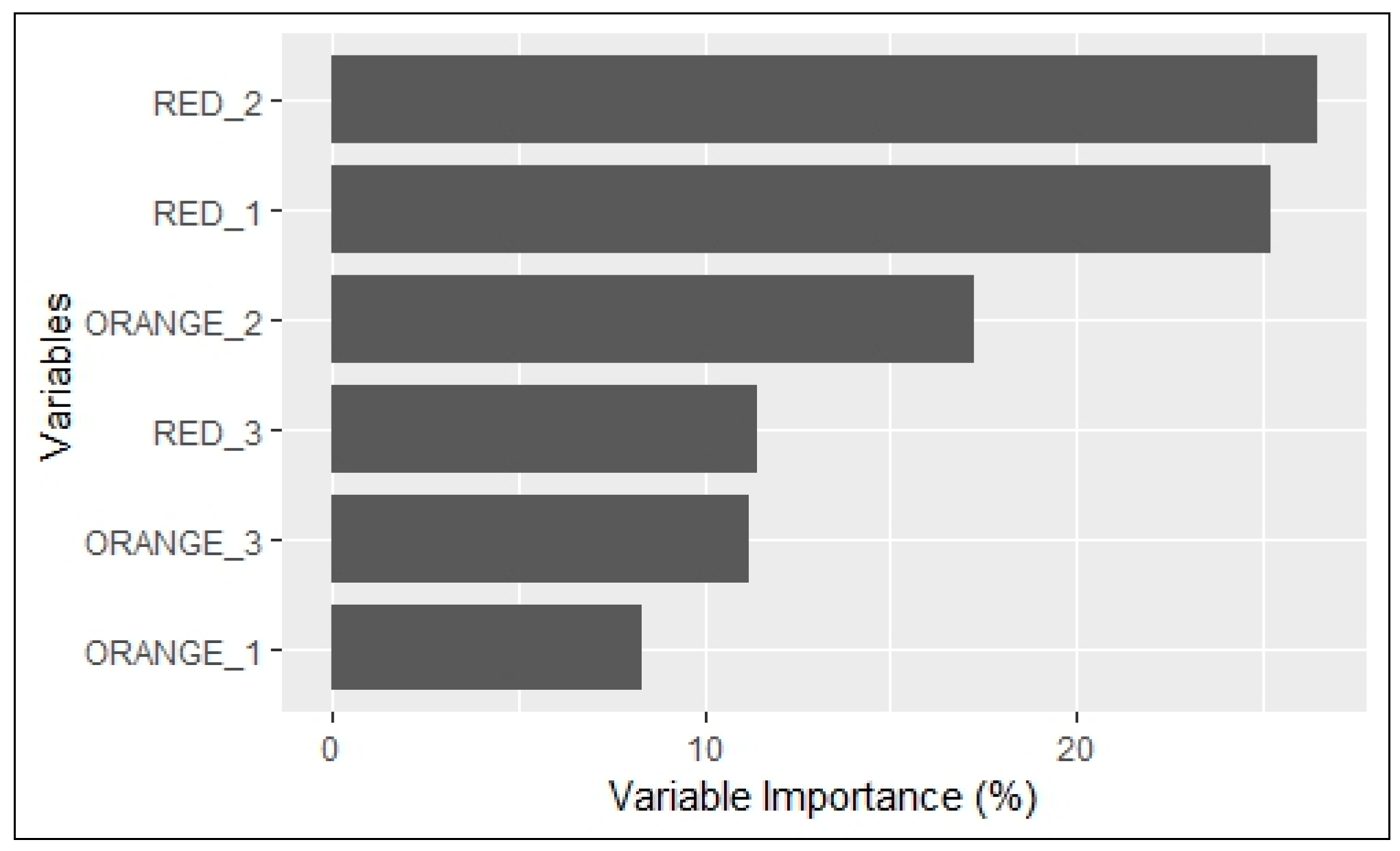
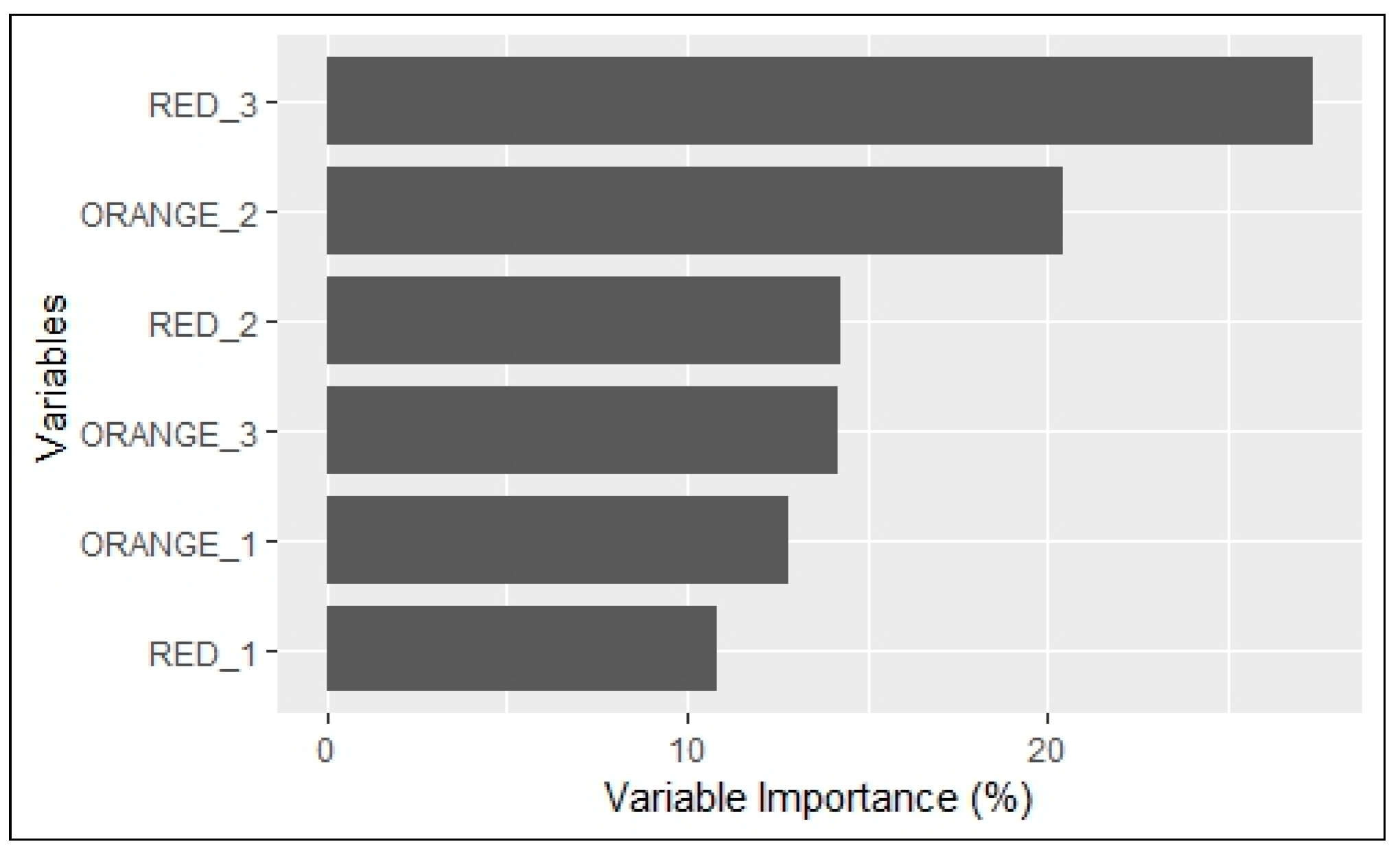
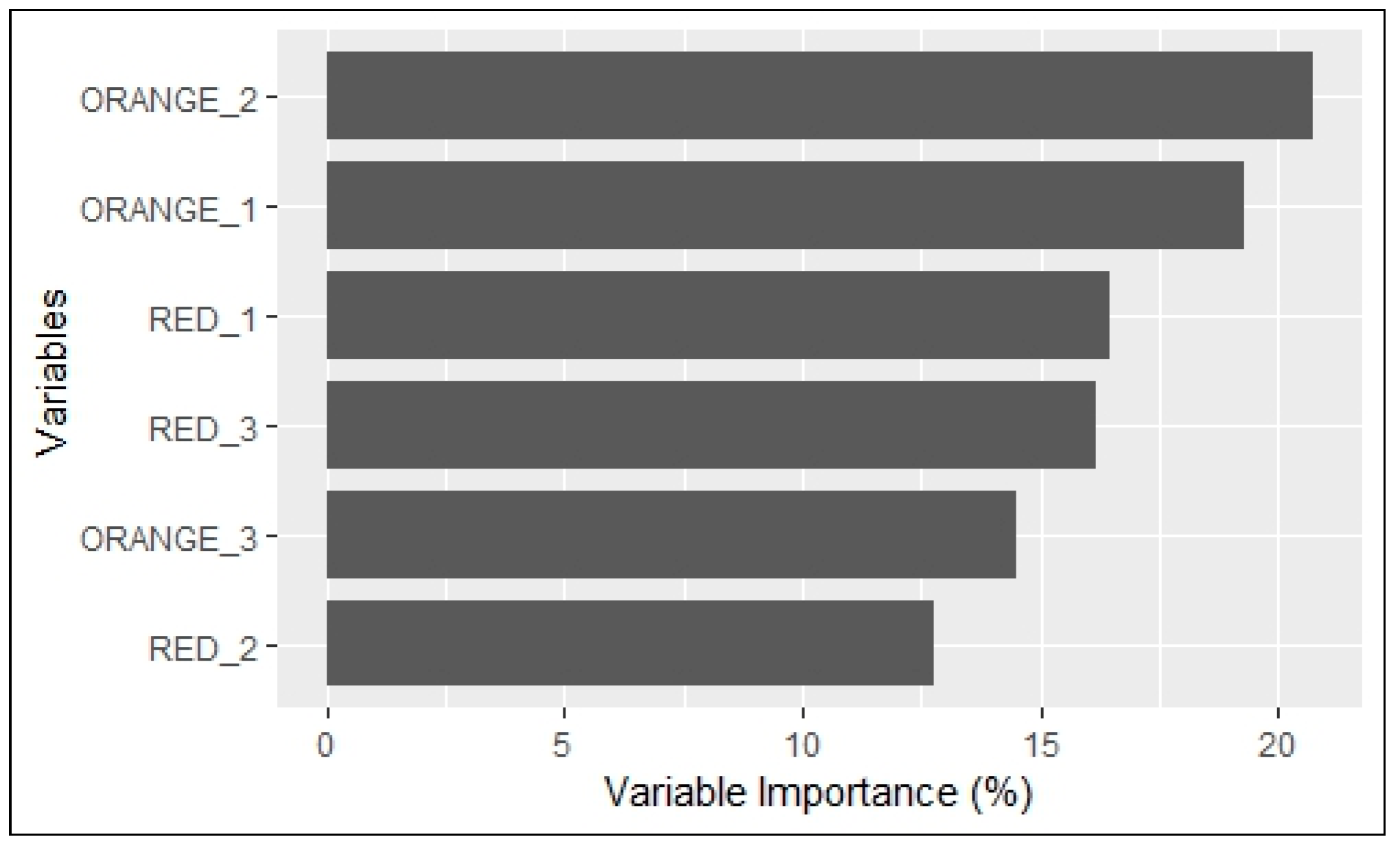
| Items | Color | Length (m) |
|---|---|---|
| 1st color from stop line | Dark red | 120 |
| 2nd color from stop line | Red | 120 |
| 3rd color from stop line | Orange | 220 |
| 4th color from stop line | Green | 9999 |
| Set of Independent Variables (IV) | Color | Name of Independent Variable | ||
|---|---|---|---|---|
| 1st Band | 2nd Band | 3rd Band | ||
| IV1 | Dark red | DARKRED_1 | DARKRED_2 | DARKRED_3 |
| Red | RED_1 | RED_2 | RED_3 | |
| Orange | ORANGE_1 | ORANGE_2 | ORANGE_3 | |
| Green | GREEN_1 | GREEN_2 | GREEN_3 | |
| IV2 | Combined red | C_RED_1 | C_RED_2 | C_RED_3 |
| Orange | ORANGE_1 | ORANGE_2 | ORANGE_3 | |
| Green | GREEN_1 | GREEN_2 | GREEN_3 | |
| IV3 | Combined red | C_RED_1 | C_RED_2 | C_RED_3 |
| Orange | ORANGE_1 | ORANGE_2 | ORANGE_3 | |
| Type of Variable | Random Forest | Gradient Boosting | Average | |||
|---|---|---|---|---|---|---|
| RMSE (Meters) | MAPE (%) | RMSE (Meters) | MAPE (%) | RMSE (Meters) | MAPE (%) | |
| Scenario 1 | ||||||
| - IV1 | 71.8337 | 63.6274 | 72.7679 | 63.4070 | 83.9077 | 71.8533 |
| - IV2 | 72.6153 | 64.5514 | 72.0657 | 64.0463 | 83.9077 | 71.8533 |
| - IV3 | 72.5919 | 64.5336 | 72.6746 | 64.3501 | 83.9077 | 71.8533 |
| Scenario 2 | ||||||
| - IV1 | 72.1760 | 63.4921 | 72.7062 | 63.7009 | 81.8285 | 70.7399 |
| - IV2 | 71.8395 | 63.9266 | 72.2615 | 63.3056 | 81.8285 | 70.7399 |
| - IV3 | 71.9597 | 64.5817 | 73.2521 | 64.1587 | 81.8285 | 70.7399 |
| Scenario 3 | ||||||
| - IV1 | 72.0496 | 63.4174 | 72.5952 | 62.8423 | 81.6131 | 70.4689 |
| - IV2 | 72.2144 | 63.8694 | 71.9686 | 62.9886 | 81.6131 | 70.4689 |
| - IV3 | 71.6170 | 63.8278 | 72.3546 | 62.8304 | 81.6131 | 70.4689 |
| M4 | M5 | M6 | M7 | ||||
|---|---|---|---|---|---|---|---|
| Variable | VI (%) | Variable | VI (%) | Variable | VI (%) | Variable | VI (%) |
| C_RED_2 | 29.616 | C_RED_2 | 26.472 | C_RED_3 | 27.398 | ORANGE_2 | 20.750 |
| C_RED_1 | 21.448 | C_RED_1 | 25.219 | ORANGE_2 | 20.467 | ORANGE_1 | 19.297 |
| C_RED_3 | 18.730 | ORANGE_2 | 17.233 | C_RED_2 | 14.254 | C_RED_1 | 16.482 |
| ORANGE_1 | 11.948 | C_RED_3 | 11.453 | ORANGE_3 | 14.222 | C_RED_3 | 16.192 |
| ORANGE_3 | 9.398 | ORANGE_3 | 11.244 | ORANGE_1 | 12.813 | ORANGE_3 | 14.517 |
| ORANGE_2 | 8.857 | ORANGE_1 | 8.376 | C_RED_1 | 10.844 | C_RED_2 | 12.759 |
Disclaimer/Publisher’s Note: The statements, opinions and data contained in all publications are solely those of the individual author(s) and contributor(s) and not of MDPI and/or the editor(s). MDPI and/or the editor(s) disclaim responsibility for any injury to people or property resulting from any ideas, methods, instructions or products referred to in the content. |
© 2023 by the authors. Licensee MDPI, Basel, Switzerland. This article is an open access article distributed under the terms and conditions of the Creative Commons Attribution (CC BY) license (https://creativecommons.org/licenses/by/4.0/).
Share and Cite
Sornsoongnern, P.; Pueboobpaphan, S.; Pueboobpaphan, R. Innovative Dynamic Queue-Length Estimation Using Google Maps Color-Code Data. Sustainability 2023, 15, 3466. https://doi.org/10.3390/su15043466
Sornsoongnern P, Pueboobpaphan S, Pueboobpaphan R. Innovative Dynamic Queue-Length Estimation Using Google Maps Color-Code Data. Sustainability. 2023; 15(4):3466. https://doi.org/10.3390/su15043466
Chicago/Turabian StyleSornsoongnern, Promporn, Suthatip Pueboobpaphan, and Rattaphol Pueboobpaphan. 2023. "Innovative Dynamic Queue-Length Estimation Using Google Maps Color-Code Data" Sustainability 15, no. 4: 3466. https://doi.org/10.3390/su15043466
APA StyleSornsoongnern, P., Pueboobpaphan, S., & Pueboobpaphan, R. (2023). Innovative Dynamic Queue-Length Estimation Using Google Maps Color-Code Data. Sustainability, 15(4), 3466. https://doi.org/10.3390/su15043466








